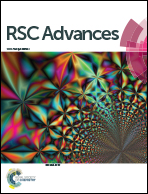Interaction behaviors and structural characteristics of zein/NaTC nanoparticles
Abstract
Bile salts are biosurfactants distributed in the human gastrointestinal tract, which can significantly influence the structure and functions of orally administrated components. This work has studied the interaction and conformation changes of zein with sodium taurocholate (NaTC) in the formation of zein/NaTC nanoparticles. When the NaTC concentration (CNaTC) increases from 0 to 0.24 g L−1, the particle size of zein/NaTC nanoparticles decreases from 97 to 76 nm, but markedly increases from 76 to 137 nm as CNaTC increases from 0.24 to 0.4 g L−1. At CNaTC = 0–0.24 g L−1, the sharply decreased zeta potential of zein/NaTC nanoparticles suggests that NaTC monomers electrostatically bind with zein molecules to form zein/NaTC complexes, which have high steric repulsion and thus aggregate into smaller zein/NaTC nanoparticles. Nevertheless, at CNaTC = 0.24–0.4 g L−1, the less changed zeta potential of zein/NaTC nanoparticles together with the surface tension result suggests that NaTC dimers formed on zein polypeptide chains due to the hydrophobic interaction cause zein/NaTC complexes to undergo more aggregation into larger zein/NaTC nanoparticles. Compared to little changes in the secondary and tertiary structures of zein molecules at CNaTC = 0–0.24 g L−1, the absorption, fluorescence, and circular dichroism measurements disclose that the addition of NaTC above 0.24 g L−1 can greatly unfold the compact structure of zein molecules with decreased α-helix content.



 Please wait while we load your content...
Please wait while we load your content...